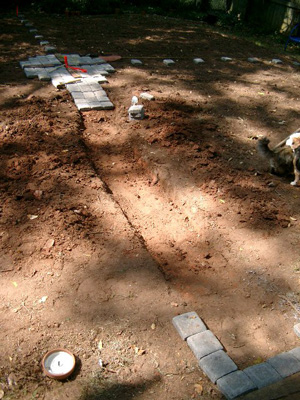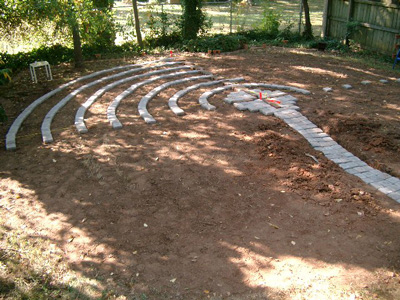
Too cold to stay out long, and too windy to have all the lights lit. But I thought this was very pretty.
In other news, there is no winter rye grass seed to be had.
Creating something every day for 365 days
I don’t have a coherent post to offer today, just random thoughts.
I’ve been having a recurring dream for the past few days. It’s annoying and I can’t figure out why I’m fixating on this particular image. It involves the Union Jack and its components somehow: I am usually trying to explain the pieces, or assemble the pieces, or explain how to assemble the pieces, or something. I’m not clear on what’s going on, and I’m thinking the dream itself is not very linear.
Sometimes a little girl is involved (hush, Jeff), sometimes a large group (hush, Jobie). The overriding feeling is one of frustration, but since I don’t have any clear (waking) idea of what I’m trying to accomplish, I’m not sure what the frustration is about. It’s entirely possible that not knowing what I’m trying to do in the dream is the frustration.
The easy symbolism is that it’s a metaphor for my composing. I know what the pieces are and have some idea of how they go together, but I don’t know enough to actually assemble them. What the little girl has to do with it, I have no idea. It’s like Faulkner’s Little Sister Death that I mentioned the other night at the Lichtenbergian Annual Meeting: in the face of some college student’s question, he claimed not even to remember the character in The Sound and the Fury. (I think I placed her in Absalom, Absalom at the meeting, but I got the character Quentin Compson right.)
As for the Lichtenbergian Annual Meeting, let’s just say that I was the essential Lichtenbergian: of the seven goals that I had listed at last year’s meeting, I had accomplished not one. The ones I can remember are picking up painting again; completing the symphony; completing the songs for A Day in the Moonlight; writing a trio for piano, trombone and saxophone; and getting some pieces done for a couple of choral competitions. There were two more, but I can’t remember even what they are.
I put off working on Moonlight to work on the symphony. That was scuttled when Czarkowski decided not to return to GHP. I didn’t have time during the summer to work on the trio, and no drive to work on the choral works, and then everything was subordinated to the labyrinth. So there you go.
All the non-Lichtenbergians in my life ask if I just rolled them all over to next year, and the answer is, of course, no. I’m pulling back in a lot of ways. Fewer goals, smaller goals, baby steps. Who knows? Perhaps the symphony will come bursting out of me in January, but I’m not planning for it.
There is too much music. Not mine, of course. Of that stuff, there’s not nearly enough. (The other day, a student asked me how much music I’ve written. According to iTunes, less than two hours worth. Feh.)
No, there’s too much music out there. I say this because as part of my fragmentary composition exercises, I went to iTunes to listen to the opening of Vaughan Williams’ 2nd Symphony, “London.” I don’t own it, and considered buying it, but then I got sidetracked by his 7th, “Sinfonia Antarctica,” a stark work. I bought it, along with his 8th. Then I got distracted by the fact that a movement from Philip Glass’s 4th Symphony, “Heroes,” was the top ringtone.
I knew I owned that, but it was not in my iTunes collection, and then I couldn’t find it on the shelf. So I bought it.
At this point, I think my iTunes collection is officially bigger than my old iPod. And I’m OK with that. The new iPod Classic will store 120GB of music, but the fact is I don’t have that kind of space on my hard drive. I could put it on my external drive, but then my music wouldn’t travel with me on my laptop.
But that’s not what I mean by “too much music.” There’s just too much to listen to and to learn and to know. Right now on my desk are two stacks of CDs, waiting for me to listen to them again and get to know them:
All of these I have listened to once, maybe twice. None have been imported into iTunes. And I just bought three new works to listen to. And I think there’s a small stack of CDs in my van that I’m supposed to be listening to.
The point is that I want to learn this music, especially the stuff that doesn’t appeal to me right away. I want to know it like I know the Beethoven symphonies, to anticipate what comes next. Sometimes that’s nearly impossible with the more atonal “modern” stuff, and sometimes I give up. But mostly I can learn almost anything. So why is there this huge stack on my desk? And why are there even more stacked over by my CD shelving?
It’s lunchtime.
I’m trying to get my brain back into “composer” mode, and to do that I’m putting myself back on a schedule, Sunday mornings and Tuesday evenings.
Further, as I listen to music in iTunes or elsewhere, I pay attention to structure, orchestration, etc., and make a note. I’m assigning these notes as “fragment exercises” for the duration. In other words, I’m not actually composing right now, I’m just using other people’s stuff as a model. In other other words, I’m copying. Think of it as a Renzuli phase II lesson. I certainly am.
My goal is simply to slap something up, to pour out the garbage and learn from hearing the stuff.
So, today’s fragment number 1 was “string arpeggios, agitato.” I think I was listening to the soundtrack for Pride & Prejudice.
(UPDATE: Each mp3 contains measures and measures of empty space at the end. Feel free to stop it and move on when the music stops. However, #3 does have one measure of silence after the first phrase. And I don’t know why #2 sounds so choppy.)
Here’s the mp3.
You will of course be alert to my dilemma this morning: this is actually pretty good. Do I keep working on it, only to bog down later, or just toss it aside and keep going? I worked a while on it, but decided to stop and move on. After all, the good work always waits.
Fragment number 2: “meandering chromatic piano line, high string accompaniment.” Again, I think this was the Pride & Prejudice soundtrack: mp3
Fragment number 3: “open fifths in strings, whole notes; countermelody in cellos/basses.” From the opening of Vaughan Williams’ Symphony #2, “London”: mp3
Fragments 2 and 3 are not as successful, but I think I got some interesting bits, like one measure or so in each. That’s all I’m after.
And so my morning ended.
The question arises, what have I been up to? I clearly have not been blogging.
Mostly that’s because I don’t have a lot to say. Actually, I might have a lot to say, but none of it is very coherent these days. Much tumbling through the brain, large galactical dust clouds, but no planets forming.
However, I can report on my latest acquisition(s).
First and foremost, I have bought a painting by Dianne Mize, my painting instructor from GHP in 1970. She and I have agreed never to mention how many years ago that was, and I’ll thank you to do the same.
Here’s the painting:

Dianne had sent me an invitation to the exhibit opening at the Tekakwitha Gallery in Helen, GA, but since it was November 1, the Saturday evening performance of Coriolanus at NCTC, I couldn’t go. When she sent an email saying the show had been held over until Christmas, I made plans to get there.
Ginny readily agreed to my idea of returning from Virginia via Helen so we could stop to see Dianne’s work. I had already decided that I would just pick one and charge it, so when Ginny offered to make me a Christmas present of whatever one I wanted, I accepted.
I also considered this painting:

It was a tough choice, obviously. I may have to have the cows later. I chose the landscape because of its subject matter. I love places like this. It reminds me of a couple of places from my life, and each of them was from a time of great happiness.
One is Snake Creek over on Parks Avenue. When I was a child, we would play there constantly, plashing in the water and running through the “woods” in that narrow strip that runs along the curve of the street. It was and is a beautiful green space.
Another is a park on the outskirts of Athens by the river. I didn’t get to go there a lot, but I remember one time, the spring of my junior year, when Kevin Reid, Cathy McQuaig, and I went for an afternoon picnic there. Kevin had become my closest friend after showing up that semester, he had dropped out of Griffin High School and just come on to UGA, and all three of us were close from working both in the costume shop and in Period Dance.
Kevin and I were a lot alike: young, precocious, serious, ferociously curious, intense readers. I know I was in love with him, and he with me, in the way young men are that verges on the physical. (Jobie, remember that piece I read out loud this summer? It was Kevin that gave my reading that passion.)
He’s dead now, of AIDS, back in the late 80s I think. I didn’t know this until last year when Ginny and I went to LA and had a reunion of a bunch of UGA theatre folk from that time. I had put together a video of all the Period Dance photos, and when we came to one of Kevin, that’s when someone told me of his death. It still hurts me, as I type this even, how I lost touch with him, and then lost him entirely.
As we sat by the river that afternoon in 1975, we knew we were enjoying a halcyon moment, and we even verbalized it. I think we knew that we would lose each other to Time, and we hugged our happiness to us even as the sun set.
That’s why I bought the landscape.

I like Dianne’s impressionistic style, her loose brushwork, and her sure sense of palette. I especially like her methods of working, and they are methods, which frustrates me when I am unable to develop similar methods for my own work in music.
However, I’m not going to whine. Let’s talk about what I am working on rather methodically, and that’s the labyrinth. I haven’t done anything since earlier in the week, of course, and now it’s raining, but I am beginning to see the endgame here.
I shall finish the curves on the pathway this week, working Tuesday and Thursday on that task. Tuesday afternoon, I order the topsoil, and with any luck will have that to play with this weekend. On Thursday, I will seek out stonecutters here in town, one of those granite countertop concerns over on the bypass, to see if they can cut the stones around the center in a more precise circular pattern. I also developed a fantasy today of checking out a four-foot piece of granite for the centerpiece. That wouldn’t be expensive at all, I’m sure.
With any kind of luck, I may have the labyrinth finished, if not this weekend, then the next. I will also be working then on coordinating the mise-en-scene of the entire backyard into something whole: columns, lighting, sculpture maybe? I don’t know. As Marc says, it seems I’m determined to become the Howard Finster of College Street.
I am hereby canceling the Quiet Strength meditation series. Trying to jumpstart my writing was a good idea, but merciful heavens what a truckload of treacle that book is!
Just scanning ahead to find a topic to write about this morning, again, trying to get something out of my head and onto the page, was enough to cause permanent pursing of the lips and raising of the brows.
And we’ll leave it at that.
I’m bored in a hotel, so I’ve picked up an old draft of a post of one of those wounded warrior meditations. Sorry.
Part of my problem with my source material is that so much of it smacks too much of “such a worm as I,” albeit in a new agey way, which probably makes it even worse. Take today’s topic. Please. [/rimshot] The point seems to be that “as boys, we learned we had to find out who others wanted us to be,” and then we had to become that person. “Now,” though, we’re ready to become our “authentic” self.
Feh.
I know that a large part of growing up is figuring out what societal norms are, and we ignore those norms at our own peril. I’m sure most of my male readership, and probably the female as well, knows all too well the pain of not conforming. If I cared what my bucking those norms has cost me in my life, it would probably drive me mad. What, don’t you think, as I do, that one of the reasons NCTC never gained traction amongst the power elite in this town is because it was led by me? And I was, well, just a little bit off?
Who among us does not understand that we are many selves, that our true “self” is this amalgamation, did you know that amalgamation was synonymous with miscegenation many years ago?, of selves, and that we do not, can not show our “true self” to anyone because there’s not a single such persona to be shown?
Yes, I show different “selves” to different people. I share different things with different people. I’ve told things to Marc that I wouldn’t feel comfortable sharing with Jeff, and heaven knows Jeff and I have chatted about things in ways that would raise others’ eyebrows, and none of you knows the things I’ve told Ginny and withheld from you. And above all, there are the things that I’ve told no one, haven’t even put into private blog posts.
(Did you know there was such a thing? If you’re not the creator of a website, there could be all kinds of blogposts you never see, like little ghosts drifting between your reading, gazing knowingly out at you in your ignorance of the full measure of your host. So… back to your reading.)
So do I have a secret self? Dern tootin’. Does that make my public selves false? I cannot think how. I’m thinking that our wounded warriors have a problem with self in the first place. Grownups in the Lylesian sense don’t worry about that. (We worry about people finding our private blogposts.)
The question arose, after Coriolanus, what next?
Other than “sit in my backyard and watch the fire with a life-giving beverage in my hand,” I hadn’t given it an awful lot of thought. But ideas have been bubbling up in my head.
 I’m still fascinated by puppets and would love to use them in something. See, as an example, Blair Thomas and Company. The drawback is the time and money; as Thomas says, “It’s such a tall order to spend the time that puppetry needs. If you take shortcuts, it’s the worst-case scenario, and the puppets are treated as props.”
I’m still fascinated by puppets and would love to use them in something. See, as an example, Blair Thomas and Company. The drawback is the time and money; as Thomas says, “It’s such a tall order to spend the time that puppetry needs. If you take shortcuts, it’s the worst-case scenario, and the puppets are treated as props.”
The works of Brecht spring to mind, especially The Good Woman of Setzuan or The Caucasian Chalk Circle. I really like Good Woman/Person and its challenge to morality, and it would be fun to develop either of those scripts.
I’d be really interested in looking at some stuff that I do not understand, and here I can give as an example of the works of Charles Mee. Mee has put all his scripts online, free for the taking/manipulating/deconstruction, and I don’t understand the theatrical impulse behind most of them. So let’s do one. As Picasso says, “I am always doing that which I cannot do, in order that I may learn how to do it.”
(Although this script by Mee is pretty powerful.)
There’s always Shakespeare. The Tempest could be fun, and of course King Lear is the Everest of them all. Or we could go all the way obscure and look at Timon of Athens or King John or Henry VIII.
I will now ramble.
I’d be interested in just developing something in that way that Marc knows how to do but I don’t.
I really liked performing in the park, the theatre not so much. I felt alive in the park, and merely observed in the theatre.
While the idea of doing a School for Scandal with the Lacuna gang brings a smile to my face, I am no longer excited by the idea of making costumes.
I liked working with all men. It will feel odd to have women in the group.
When I look at stuff like Charles Mee or photos of other company-developed pieces, I often think that I don’t have anything to say in such a piece.
I am also skeptical of the power of non-narrative pieces. I want to be convinced otherwise.
I like the idea of looking at the Neo-Futurists for real.
We could set aside a short period, three or four weeks, Wednesdays only, and study a text, then quit. Ideas and lines of energy might emerge, and that would be fine. Or not.
I need to work on music.
As you probably know, because half of you are in it, this weekend is the Lacuna Group’s all-male production of Coriolanus. It’s going to be entertaining. You should probably see it.
But what most of you don’t know is that this weekend was to have been the international world premiere of A Visit to William Blake’s Inn. In fact, at this very moment, we’d be at the reception honoring the production team, our international guests, and of course Nancy Willard, after what we can only assume would have been the triumphant opening performance.
Back when we were working to engage the community’s interest in the piece, we had to book the Centre for Performing and Visual Arts eighteen months in advance, and Don Nixon was more than willing to do that, so I found out when would be convenient for Nancy to come down, and this weekend was best. (It is Vassar’s fall break.) I marked it in my iCal. When the whole proposal fell through, I decided to leave it there so that I could watch it go by as time slipped away.
And slip away it has, has it not?
 Here’s where I picked up today. Actually, I started by pulling out my new cutting thingie and assembling it, reading the directions more carefully than anything I’ve ever read. This thing will put your eye out, if not cut off your leg.
Here’s where I picked up today. Actually, I started by pulling out my new cutting thingie and assembling it, reading the directions more carefully than anything I’ve ever read. This thing will put your eye out, if not cut off your leg.
Alas, it only produces a cut that’s less than half an inch deep. What the hell kind of masonry is only half an inch thick? These paving stones are two inches, so the paltry little slice the fairly expensive device made is worthless. It goes back to Home Depot tomorrow.
And now I’m back to where I began: how do I cut the curves for the center?
I decided to forge ahead and start laying the thing out. I can always come back and cut curves later.
I had already figured out east/west/north/south, but now I staked out the whole circle. I cut a piece of wood exactly three stones wide, and began by laying out the three axes:

And then, something that I have never seen before in all my studies of modern labyrinths. I think it might actually be An Innovation.


All right, class, can you see what I’ve done here? Would anyone like to tell me what I’m up to? What is this Innovation of which I am so inordinately proud?
Along the western axis, I have laid out bricks in the circuit:

They’re kind of hard to see in the photo. They actually extend the idea of the Innovation, if you consider its role as a Tolkien reference.
Finally, I began to lay out the circuit:

Here’s the southwestern quadrant, all laid out. I was gratified/amazed to find that the outer circle exactly touched the brick edging. It was absolutely a perfect fit. Here it is from the picnic table area:

It will probably take most of my remaining pavers to do the northwestern quadrant, the other half of the great semicircles that form the top of the labyrinth. I’ll have to order another pallet, have it delivered Friday. Ginny’s going out of town to Virginia again, so I’ll have all weekend to finish laying out the bottom half, with all the turnarounds and switchbacks. That will be the interesting part.
So, has everyone figured out what I’m doing down the middle there?